Research
We carry out epidemiological studies on different health related aspects of brain aging and the elderly. A summary of the main research findings are reported below:
Risk factors of Alzheimer’s disease and dementia
Multimorbidity and physical functioning
The emerging elderly people in Bangladesh. Aspects of their health and social situation
The Kungsholmen project in Nordanstig
Risk
factors of Alzheimer’s disease and dementia
It has been already been shown by us and by others that high blood pressure
is a risk factor for dementia. Our group was the first to demonstrate
that the use of antihypertensive drugs may decrease the risk of dementia
and Alzheimer´s disease (Qiu et al, Am J Epidemiol 2001).
We have now suggested a possible mechanism accounting for this finding:
antihypertentensive drugs may counteract the combined effect on dementia
due to the genetic risk factor apoE-e4 and high systolic blood pressure
(Qiu et al, Neurology 2003).
We found that not only high blood pressure but also low diastolic blood
pressure was associated with increased risk of dementia. The direction
of causality remains unclear, as dementia pathology may lower blood pressure
even some years before diagnosis (Qiu et al, Arch Neurol 2003).
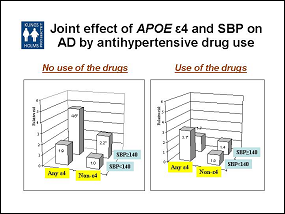
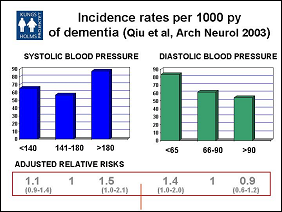
It has consistently
been reported that subjects with low education are at a higher risk to
develop dementia and Alzheimer´s disease (Qiu et al, Arch Neurol
2001). We tried to verify whether this association was due to factors
related to lower socio-economic status. An increased risk of dementia
was found in subjects with only elementary schooling independently of
their occupation-based socio-economic status or socio-economic mobility
during life. These findings suggest that factors operating during the
first two decades of life are relevant for the development of dementia
in late life (Karp et al, Am J Epidemiol 2004).
After the first report of a 60% increased risk of dementia among subjects
with poor or limited social network (Fratiglioni et al, Lancet 2000),
we have confirmed that intellectual and social stimulation protects against
dementia (Wang et al, Am J Epidemiol 2002). This result was based
on the engagement in different leisure activities assessed 6 year before
the dementia diagnosis. These findings were recently confirmed by three
American research groups. The topic has been systematically reviewed in
Fratiglioni et al, Lancet Neurology 2004.
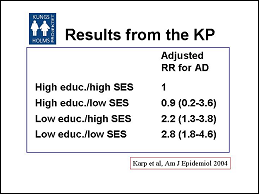
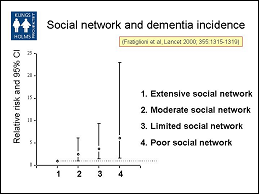
Multimorbidity
and physical functioning
Multimorbidity and disability are related to major outcomes such as mortality
and institutionalisation (Agüero-Torres et al, J Clin Epidemiol 2001).
A large proportion of nonagenarians are functionally independent (73%)
despite their advanced age, and 19% have no diseases at all (von Strauss
et al, J Am Geriatr Soc 2000). The gender distribution of morbidity, mortality
and disability are modified by age. Women 90 years and older are more
disabled than men of same age, partially due to the excess of dementia
and other chronic diseases
(von Strauss et al, J Clin Epidemiol 2003).
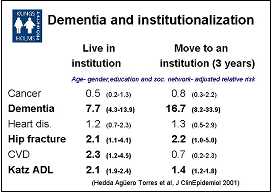
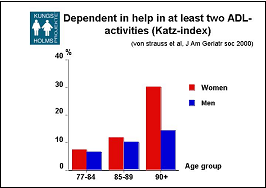
Mild
cognitive impairment
To differentiate normal age-related cognitive decline from impairment
that will lead to dementia, a new entity has been suggested, denominated
as Mild Cognitive Impairment (MCI). Most of the research performed until
now is based on patients derived from clinical settings. We tried to verify
the predictivity of the cognitive impairment in the non-dementia subjects.
We found that only one third of these subjects will develop dementia in
three years, whereas one third will remain stable or even improve. The
improvers will not have an increased risk of dementia even if followed
for three more years (Palmer et al, Am J Psychiatr 2002).
In order to identify a procedure that can lead to the early detection
of dementia and AD in the preclinical phase, we tested the predictivity
of a three-step procedure, which simulates daily clinical practice: a)
reports of memory problems; b) administration of a simple cognitive test;
c) assessment with a complete neuropsychological battery. Almost all persons
(positive predictive value ranging from 85 to 100%) with memory complaints,
impairment on the global cognitive test, and deficits in specific cognitive
domains will develop dementia over 3 years. Unfortunately, this procedure
can identify only 18% of all future demented subjects. These results have
received much attention both in the research world (Palmer et al,
BMJ 2003) and in the general public through news and media.
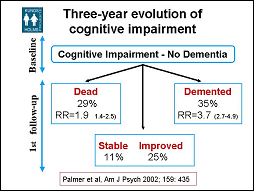
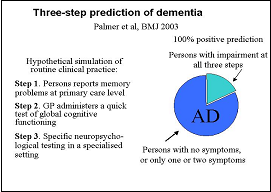
Cognitive
functioning
Our research indicates that persons who will go on to develop AD show
deficits in multiple cognitive domains (i.e., episodic memory, verbal
fluency) up to six years before clinical diagnosis (Bäckman et
al, Brain 2001; Small et al, Arch Neurol 2000). We have now established
the existence of a preclinical period with cognitive deficits not only
in AD, but also in vascular dementia (Jones et al, Dementia 2004;
Jonsson Laukka et al, JINS and Stroke 2004). Persons that develop
vascular dementia have reduced memory functioning up to 6 years before
clinical diagnosis. We have also shown that mortality-related cognitive
deficits generalize across different causes of death (Small et al,
Psychol Aging 2003), that age differences are pronounced for episodic,
but not for semantic, memory over the life span (Nyberg et al, Psychol
Aging 2003), and that persons who will develop both AD and depression
over three years have somewhat more marked cognitive deficits at baseline
compared to those who will develop AD alone (Berger et al, Cortex
2004). All cognitive research that we have conducted within the Kungsholmen
Project was integrated in an extensive review article (Bäckman
et al, Aging Neuropsychol Cognit 2004).
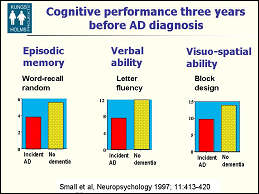
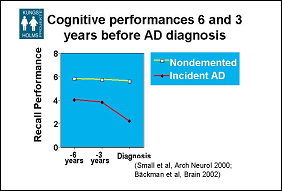
Pharmacoepidemiology
In a project together with the Swedish National Board of Health and Welfare
quality indicators for drug use in the elderly were developed (National
Board of Health and Welfare 2003). The indicators have also recently
been used in a computerised analysis of data from the ApoDos-database
(National Board of Health and Welfare and Apoteket AB, in press),
showing both extensive drug use and inappropriate drugs and drug combinations
(see figure below). They are also employed in drug utilisation reviews
in nursing homes throughout the country. These indicators were used in
the Kungsholmen Project showing evidence of inappropriate drug use in
both demented and non-demented elderly, but with different patterns (Giron
et al, J Am Geriatr Soc 2001).
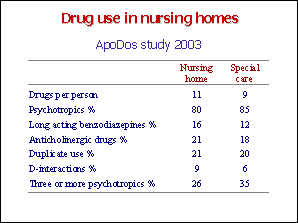
A study of
the use of antidepressants in nursing homes showed deficient routines
both for diagnosing depression and for evaluating the antidepressant therapy
(Fastbom and Schmidt, Rapporter Äldrecentrum 2003). In collaboration
with Äldrecentrum, drug use was investigated in elderly persons with
multiple morbidity. The drug use was both extensive (on average 10 drugs
per person) and of poor quality (Gurner and Fastbom, Rapporter Äldrecentrum
2002, 2004)
A study comparing the rural Nordanstig with the Kungsholmen population
showed a higher use of cardiovascular (CV) drugs but a lower use of aspirin,
suggesting an under use of CV prevention. Also the under utilisation of
modern CV drugs in cognitively impaired elderly was confirmed (Klarin
et al, Drug Safety 2003).
A longitudinal study of the Kungsholmen population showed that no one
of the NSAID users developed Alzheimer’s disease (AD) during a 3
year follow-up, thus confirming previous findings of a protective effect
of NSAID against AD. In contrast, a higher risk for AD was observed in
apoE-e4-negative users of aspirin (Cornelius et al, Neuroepidemiology
2004).
Health
economy
We have shown that costs for community care, informal care and total costs
of care increase, while proxy-rated utility and quality of life decreases
with the degree of cognitive impairment in AD patients (Jönsson et
al, Thesis Karolinska Institutet 2003). Model simulations employed to
simulate the progressive cognitive impairment of AD patients on costs
and transition probabilities, show that even modest and short-term effects
on the progression of AD can be associated with important cost-savings
and gains in quality-adjusted life-years (Jönsson et al, Thesis Karolinska
Institutet 2003).
In a study focusing on activities in terms of support in personal ADL
(activities of daily living), Instrumental ADL, and supervision/surveillance
according to the RUD instrument (Resource Utilization in Dementia), we
found that support in IADL and supervision/surveillance constituted a
great proportion of informal care, while support in ADL (which by tradition
is the focus for assessments of informal care), was less than 1/5 of the
total time (Wimo et al, Int J Geriatr Psychiatry 2000).
Well-being
in the elderly
Well-being among the very old:
A survey on a sample aged 90 years and above
This study examined well-being among the very old and the factors believed
to influence the three components of wellbeing called life satisfaction,
positive affect, and negative affect. It also examined activity patterns,
the factors related to activity, and the consequences of different types
of activity on well-being. The study is part of the Kungsholmen project
and covers 105 subjects that were 90 years and older, scoring 24 points
or above on the Mini-Mental State Examination. Wellbeing was assessed
with the Positive and Negative Affect Schedule and the Life Satisfaction
Index-Z. Results show that personality emerged as the major determinant
of well-being. In addition, this age group has a low activity level, which
is affected by factors such as health, personality, and life events. Although,
introverts cannot be turned into extroverts, the study suggests ways to
try to directly enhance very old people's levels of life satisfaction
and positive affect with reading groups, social support groups, and physical
activity groups.
Researchers:
Pernilla Hillerås, Agneta Herlitz, Anthony Jorm, Kjerstin Ericsson,
Bengt Winblad, Jo Medway, Penelope Pollit.
Well-being
and self-care strategies in aStockholm population (20-64 years).
The main objective of this research project is to study the importance
of self-care strategies for well-being and mental illness, and to study
how they differ between groups. A panel survey has been used, thus making
the measurement of age, and time effects possible. The recruited participants
complete a questionnaire designed to assess sociodemographic variables,
social network, life events, working conditions, and health status. The
questionnaire also examines psychological well-being as well as symptoms
of psychiatric disorders. To evaluate the diagnoses from the questionnaire,
psychiatrists and a psychologist interview a selected sample. The follow-up
has already started. The implication of this study is to analyze the importance
of self-care strategies in the development of mental illness. Knowledge
concerning self-care strategies could help to improve the prevention of
mental illness.
Researchers: Anna Hansson, Yvonne Forsell och Pernilla Hillerås
Well-being and drugs among the very old (85+)
The aim of the study is to evaluate drugs and the effect on well-being
among the very old (age 85 and older). The study is a part of the Kungsholmen
project. A series of instruments were used in the interview concerning
well-being and also drug information with control for diagnoses which
might influence well-being in the very old. The study will result in an
increased understanding about the influence of drugs and experiences of
well-being. The administration of drugs among the elderly living in nursing
homes will also be evaluated, and what nurses do to make drug administration
easier for the elderly will also be investigated. The result will increase
our knowledge concerning subjective feelings of well-being and attitudes
toward drugs among the very old. In addition, the result of present study
can increase the knowledge and competence of those working in nursing
schools, social districts, and nursing homes and, thus, foster a greater
understanding of this group of very old adults.
Researchers: Margareta Westerbotn, Pernilla Hillerås, Hedda Agüero-Eklund, Johan Fastbom, Bengt Winblad
Family-based
dementia care: Experiences from the perspective of spouses and adult children
Study I aimed to investigate how adult children (n=81) experienced their
role as primary caregivers of parents suffering from dementia. They were
compared with children of parents without dementia (n=102). Daughters
and sons were interviewed about burden experienced, their co-operation
with the informal and formal network, and their willingness to remain
as caregivers during the progression of the disease or aging process.
The results showed that the daughters reported more affection due to the
caregiving role than the sons. About one third of the participants could
not get relief from someone else. A vast majority of the children were
not willing to remain as caregivers and care for the parent in the family
home during the progression of the disease, even if they were employed
as caregivers.
Study II describes 17 daughters´ present feelings after many years
of caregiving. The motives that elicit and sustain their helping behavior
towards parents with dementia were also investigated. Transcribed interviews
were analyzed by means of coding and categorization. Despite the parents´
moving to an institution all the daughters continued to feel responsibility
for the well-being of the elderly parent. The daughters still experienced
constraints in their caregiving role and also feelings of loneliness.
Most of the daughters could, however, express positive feelings in connection
with caregiving. Affection and reciprocity emerged as the most common
motives for caring.
The aim of study III was to compare subjective experiences of family caregivers
of individuals with different disease diagnoses. Comparisons were also
made concerning relationships, and between caregivers of persons living
in different housings. Descriptive statistics were used to analyze interview
data on 268 caregivers. The findings confirmed those of earlier studies,
that caregiving most greatly effects caregivers of people with dementia.
A surprising finding was that caregivers of visually impaired persons
reported strain and negative feelings in relation to the relative, as
well as burden due to the caregiving role. Significant results also showed
that women more often reported negative affect as did family caregivers
whose relative lived in an institution.
The aim of study IV was to describe which caring activities eight spouses
performed when caring for a partner with dementia. The dyads were observed
in their homes. A qualitative approach was chosen to discover qualities
and describe patterns of spousal caregiving in dementia care. Findings
from the study shed some light on the invisible aspects besides the traditional
hands-on caregiving. The spouses were caring for as well as about their
partners.
In the intervention study (V), family caregivers and volunteers were trained
together in study-circles. Thereafter, the volunteers replaced the caregivers
in the homes on a regular basis permitting the caregivers some relief
from the demands of caregiving. Interviews were conducted with the participants
to gather information about their training and relief-care experiences.
The analysis of the transcribed interviews revealed that the study-circle
provided the caregivers an opportunity to exchange experiences with other
people in a similar situation and increased their knowledge about care
providing. The temporary relief-care by the volunteers provided the relatives
with feelings of security and relaxation. The satisfaction among the Circle
Model participants was reciprocal. The volunteers also reported high satisfaction
and appreciation for the knowledge received
Researcher: Wallis Jansson
Caregiver
contributions in home care based dementia care - its consequences and
health economical effects
The project describes caregivers' efforts toward demented persons living
at home from a health economical point of view. Caregivers are interviewed
with a structured questionnaire. Caregivers' efforts in terms of support
in ADL, IADL, and surveillance are assessed in detail and in physical
units and in the next step expressed in terms of costs of informal care.
The fieldwork is almost complete. Doctoral student: Gunilla Nordberg.
Researchers: Eva von Strauss, Anders Wimo, Margareta Grafström, Gunilla Nordberg.
The
emerging elderly people in Bangladesh
Aspects of their health and social situation
Bangladesh is one of the twenty countries in the world
with the largest elderly populations. This project aimed to establish
a knowledge base about aspects of the health and social situation of elderly
people in rural and urban Bangladesh. It also aimed to adapt existing
instruments assessing health status in terms of gender sensitivity and
cultural relevance in the cultural context of Bangladesh. A survey of
786 elderly (aged 60 years or older) men and women was conducted in collaboration
with a local organization in Bangladesh.
Continuation of traditional norms in the elderly population
Socio-economic and demographic characteristics of elderly persons in Bangladesh
indicate that: a high proportion of men (approximately 90%) were married
while most women were widowed (67%); 98% of all elderly people reported
having children; intergenerational co-residence with sons was common;
and more than 70% of elderly men reported being in paid work while elderly
women reported unpaid work.
Cognitive test for an illiterate population
The Bangla Adaptation of Mini-mental State Examination, BAMSE, a modified
Mini-Mental State Examination (MMSE), adapted for the cultural context
of Bangladesh and not requiring literacy as a precondition, demonstrated
satisfactory test properties in comparison to MMSE. Association between
the two instruments was significant (r=0.57), and the testretest reliability
was good (r=0.70). More importantly, BAMSE was found to be less sensitive
to age and education than MMSE.
Contextualizing functional ability
Modified assessment instruments of activities of daily living (ADL) and
instrumental activities of daily living (IADL) indicated differential
performance in ADL and IADL tasks by gender and region. Socio-economic
status was found to influence IADL tasks only. Empirical data regarding
type of help used and reason for not performing a task enables understanding
of sociocultural and structural influence on functional ability. Based
on this data, socio-cultural and structural factors are suggested to be
strong determinants of task performance.
High prevalence of self-reported health-problems
More than 95% of the elderly people reported experiencing health problems,
and most reported multiple health problems. More health problems were
reported by women compared to men, and more were reported in the rural
region compared to the urban. Socio-economic factors were found to have
little influence on the reporting of health problems. Irrespective of
age, sex, and area of residence, those reporting a greater number of health
problems were more likely to report difficulty with at least one ADL task.
Support is mutual
Support from family members in old age was found to be strong in Bangladesh.
The role of providers of support, i.e. emotional, practical, or material,
was primarily shared between spouse, daughter, son, and daughter-in-law.
While elderly people reported receiving support from their family members,
they also reported providing support in the functioning of their own households,
both financially and with household activities.
Researchers: Zarina Nahar Kabir, Bengt Winblad
The Kungsholmen project in Nordanstig
Since 1995, there has been a twin project of the Kungsholmen project that is ongoing in the municipality of Nordanstig, in the northern part of the county of Hälsingland. The project is entitled "The Kungsholmen Project and Nordanstig". The project is a collaboration between the municipality of Nordanstig, the Primary Health Care in Nordanstig, and the Stockholm Gerontology Research Center. About 920 persons aged 75 years and older participated in phase I of the project. Some features regarding rural conditions have been added to the protocol, i.e. measurements of distances to various social and medical resources. A new part of the Nordanstig project and the base project in Kungsholmen is that caregiver efforts are assessed in terms of support in ADL, IADL, and surveillance. In the next step, there is a plan to estimate these figures in monetary terms (costs). Time schedule: The database in phase I was completed in January-February 1998. Two doctoral students have been enrolled, and the database can serve as a basis for several theses. Phase II of the project began in 1999 and the fieldwork was completed during March 2001. Preliminary analyses have begun.
Principal investigator: Anders Wimo, GP, Associate Professor, The Primary Health Care in Bergsjö, Nordanstig.
Collaborators: Head of social services Gert Persson, MAS (chief municipality nurse) Britt Mari Sjölund, Nordanstig's Communitity. Professor Laura Fratiglioni, Associate professor Matti Viitanen, Professor Bengt Winblad, Dr Eva von Strauss RN, Stockholm Gerontology Research Center, Stockholm.